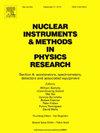Spatiotemporal correction of ultrashort electron beam with radially polarized laser
IF 1.5
3区 物理与天体物理
Q3 INSTRUMENTS & INSTRUMENTATION
Nuclear Instruments & Methods in Physics Research Section A-accelerators Spectrometers Detectors and Associated Equipment
Pub Date : 2025-03-31
DOI:10.1016/j.nima.2025.170455
引用次数: 0
Abstract
The manipulation of ultrashort electron beams, particularly in the sub-femtosecond range, faces significant challenges due to the spherical aberration and temporal distortion caused by magnetic components during the beam’s generation and transport. These challenges critically affect the spatial and temporal distribution of the beams, limiting their potential for further applications. In this paper, we propose a novel optical correction method that uses a focused radially polarized laser to simultaneously correct both spherical aberration and temporal distortion. Under the assumption of no space charge effects, simulation results present remarkable improvements, with a 65.3% reduction in transverse beam size, a 48.5% reduction in transverse normalized emittance, and an effective mitigation of temporal distortion. These improvements in beam quality provide unprecedented opportunities for the spatiotemporal manipulation of ultrashort electron beams and their broader applications.
求助全文
约1分钟内获得全文
求助全文
来源期刊
CiteScore
3.20
自引率
21.40%
发文量
787
审稿时长
1 months
期刊介绍:
Section A of Nuclear Instruments and Methods in Physics Research publishes papers on design, manufacturing and performance of scientific instruments with an emphasis on large scale facilities. This includes the development of particle accelerators, ion sources, beam transport systems and target arrangements as well as the use of secondary phenomena such as synchrotron radiation and free electron lasers. It also includes all types of instrumentation for the detection and spectrometry of radiations from high energy processes and nuclear decays, as well as instrumentation for experiments at nuclear reactors. Specialized electronics for nuclear and other types of spectrometry as well as computerization of measurements and control systems in this area also find their place in the A section.
Theoretical as well as experimental papers are accepted.

 求助内容:
求助内容: 应助结果提醒方式:
应助结果提醒方式:


